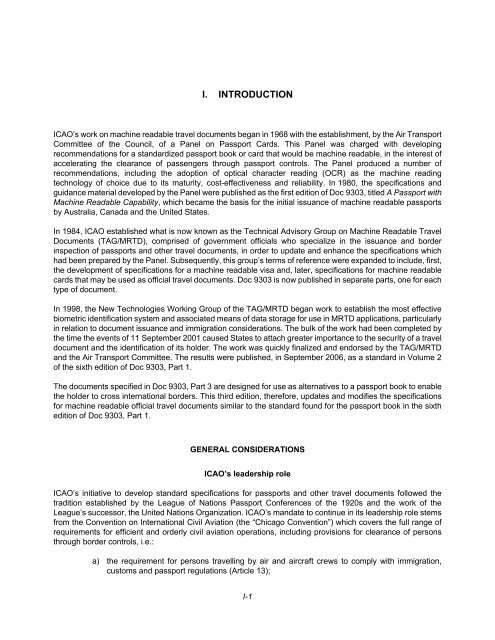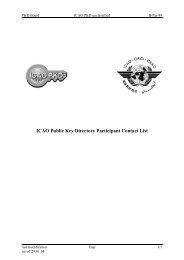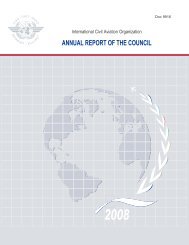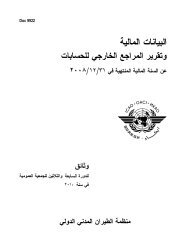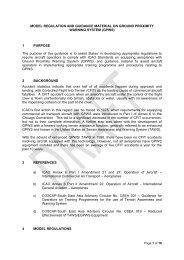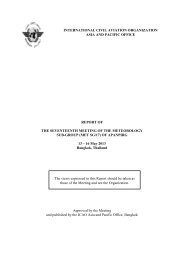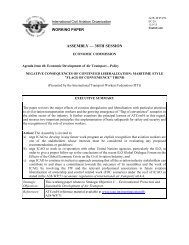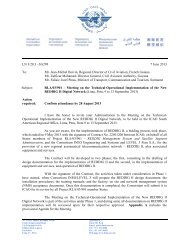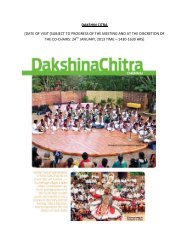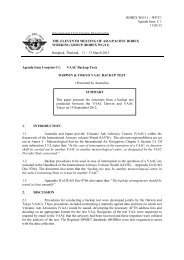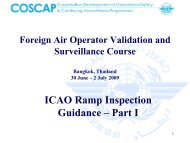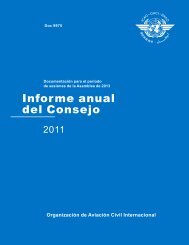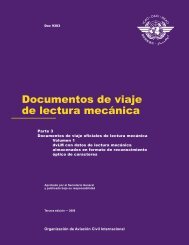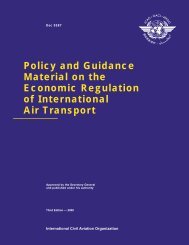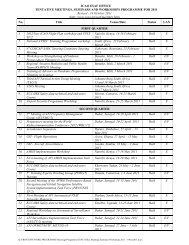Machine Readable Travel Documents - ICAO
Machine Readable Travel Documents - ICAO
Machine Readable Travel Documents - ICAO
You also want an ePaper? Increase the reach of your titles
YUMPU automatically turns print PDFs into web optimized ePapers that Google loves.
I. INTRODUCTION<br />
<strong>ICAO</strong>’s work on machine readable travel documents began in 1968 with the establishment, by the Air Transport<br />
Committee of the Council, of a Panel on Passport Cards. This Panel was charged with developing<br />
recommendations for a standardized passport book or card that would be machine readable, in the interest of<br />
accelerating the clearance of passengers through passport controls. The Panel produced a number of<br />
recommendations, including the adoption of optical character reading (OCR) as the machine reading<br />
technology of choice due to its maturity, cost-effectiveness and reliability. In 1980, the specifications and<br />
guidance material developed by the Panel were published as the first edition of Doc 9303, titled A Passport with<br />
<strong>Machine</strong> <strong>Readable</strong> Capability, which became the basis for the initial issuance of machine readable passports<br />
by Australia, Canada and the United States.<br />
In 1984, <strong>ICAO</strong> established what is now known as the Technical Advisory Group on <strong>Machine</strong> <strong>Readable</strong> <strong>Travel</strong><br />
<strong>Documents</strong> (TAG/MRTD), comprised of government officials who specialize in the issuance and border<br />
inspection of passports and other travel documents, in order to update and enhance the specifications which<br />
had been prepared by the Panel. Subsequently, this group’s terms of reference were expanded to include, first,<br />
the development of specifications for a machine readable visa and, later, specifications for machine readable<br />
cards that may be used as official travel documents. Doc 9303 is now published in separate parts, one for each<br />
type of document.<br />
In 1998, the New Technologies Working Group of the TAG/MRTD began work to establish the most effective<br />
biometric identification system and associated means of data storage for use in MRTD applications, particularly<br />
in relation to document issuance and immigration considerations. The bulk of the work had been completed by<br />
the time the events of 11 September 2001 caused States to attach greater importance to the security of a travel<br />
document and the identification of its holder. The work was quickly finalized and endorsed by the TAG/MRTD<br />
and the Air Transport Committee. The results were published, in September 2006, as a standard in Volume 2<br />
of the sixth edition of Doc 9303, Part 1.<br />
The documents specified in Doc 9303, Part 3 are designed for use as alternatives to a passport book to enable<br />
the holder to cross international borders. This third edition, therefore, updates and modifies the specifications<br />
for machine readable official travel documents similar to the standard found for the passport book in the sixth<br />
edition of Doc 9303, Part 1.<br />
GENERAL CONSIDERATIONS<br />
<strong>ICAO</strong>’s leadership role<br />
<strong>ICAO</strong>’s initiative to develop standard specifications for passports and other travel documents followed the<br />
tradition established by the League of Nations Passport Conferences of the 1920s and the work of the<br />
League’s successor, the United Nations Organization. <strong>ICAO</strong>’s mandate to continue in its leadership role stems<br />
from the Convention on International Civil Aviation (the “Chicago Convention”) which covers the full range of<br />
requirements for efficient and orderly civil aviation operations, including provisions for clearance of persons<br />
through border controls, i.e.:<br />
a) the requirement for persons travelling by air and aircraft crews to comply with immigration,<br />
customs and passport regulations (Article 13);<br />
I-1


